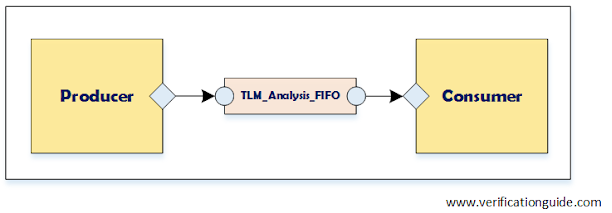UVM TLM FIFO用法總結
-
目录
一、TLM FIFO Overview
二、TLM FIFO Classes
三、TLM FIFO Methods
3.1、new
3.2、size
3.3、used
3.4、is_empty
3.5、is_full
3.6、flush
四、Summary of TLM FIFOs
The TLM FIFO provides storage for the transactions between two independently running processes. We have seen put and get methods operates with only one outstanding transaction at a time i.e it is allowed to send the transaction Only after consumption of the previously sent transaction, in this case, the sender and receiver must be in sync else lead to blocking in one of the components.
What if the case where the sender needs not wait for the receiver acknowledgment, it just wants to store it in memory and the receiver can consume whenever required. in this sender and The receiver needs not to be in sync. Yes With TLM FIFO it is possible.

一、TLM FIFO Overview
- In TLM FIFO, the sender pushes the transactions to FIFO and whenever it required reiver pops it out or fetches from the FIFO
- Transactions are put into the FIFO via the put_export method
- Transactions are fetched from the FIFO via the get_peek_export method
- As its FIFO (First In First Out), transactions are fetched from the FIFO in the order they are put
二、TLM FIFO Classes
uvm_tlm_fifo #(T)This class provides storage of transactions between two independently running processes
三、TLM FIFO Methods
3.1、new
- This is a constructor method used for the creation of TLM FIFO
function new (string name,
uvm_component parent,
int size=1);- The name and parent are the normal uvm_component constructor arguments
- The size indicates the maximum size of the FIFO; a value of zero indicates no upper bound
3.2、size
- Calling size() returns the size of the FIFO
- A return value of 0 indicates the FIFO capacity has no limit
3.3、used
- Returns the number of entries put into the FIFO
3.4、is_empty
- Returns 1 when there are no entries in the FIFO, 0 otherwise
3.5、is_full
- Returns 1 when the number of entries in the FIFO is equal to its size, 0 otherwise
3.6、flush
- Calling flush method will Remove all entries from the FIFO
- after the flush method call used method returns 0 and the is_empty method returns 1
四、Summary of TLM FIFOs

五、TLM Analysis FIFO Example
5.1、

5.2

5.2、Implementing analysis port in comp_a
class component_a extends uvm_component;
transaction trans;
//Step-1. Declaring analysis port
uvm_analysis_port#(transaction) analysis_port;
`uvm_component_utils(component_a)
//---------------------------------------
// Constructor
//---------------------------------------
function new(string name, uvm_component parent);
super.new(name, parent);
//Step-2. Creating analysis port
analysis_port = new("analysis_port", this);
endfunction : new
//---------------------------------------
// run_phase
//---------------------------------------
virtual task run_phase(uvm_phase phase);
phase.raise_objection(this);
trans = transaction::type_id::create("trans", this);
void'(trans.randomize());
`uvm_info(get_type_name(), $sformatf(" tranaction randomized"), UVM_LOW)
`uvm_info(get_type_name(), $sformatf(" Printing trans, n %s", trans.sprint()), UVM_LOW)
`uvm_info(get_type_name(),$sformatf(" Before calling port write method"),UVM_LOW)
//Ste-3. Calling write method
analysis_port.write(trans);
`uvm_info(get_type_name(), $sformatf(" After calling port write method"), UVM_LOW)
phase.drop_objection(this);
endtask : run_phase
endclass : component_a5.3、Implementing analysis FIFO in comp_b
class component_b extends uvm_component;
transaction trans;
//Step-1. Declaring analysis FIFO
uvm_tlm_analysis_fifo #(transaction) analy_fifo;
`uvm_component_utils(component_b)
//---------------------------------------
// Constructor
//---------------------------------------
function new(string name, uvm_component parent);
super.new(name, parent);
//Step-2. Creating analysis FIFO
analy_fifo = new("analy_fifo", this);
endfunction : new
//---------------------------------------
// run_phase
//---------------------------------------
virtual task run_phase(uvm_phase phase);
phase.raise_objection(this);
#100;
`uvm_info(get_type_name(), $sformatf(" Before calling analysis fifo get method"), UVM_LOW)
//Step.3 - Getting trans from FIFO
analy_fifo.get(trans);
`uvm_info(get_type_name(), $sformatf(" After calling analysis fifo get method"), UVM_LOW)
`uvm_info(get_type_name(), $sformatf(" Printing trans, n %s",trans.sprint()), UVM_LOW)
phase.drop_objection(this);
endtask : run_phase
endclass : component_b5.4、Connecting analysis port and analysis FIFO in env
function void connect_phase(uvm_phase phase);
//Connecting analysis port to analysis FIFO
comp_a.analysis_port.connect(comp_b.analy_fifo.analysis_export);
endfunction : connect_phase
最后
以上就是笑点低宝贝最近收集整理的关于[UVM]UVM TLM FIFO使用方法總結 UVM TLM FIFO用法總結的全部内容,更多相关[UVM]UVM内容请搜索靠谱客的其他文章。




![[UVM]UVM TLM FIFO使用方法總結 UVM TLM FIFO用法總結](https://file2.kaopuke.com:8081/files_image/reation/bcimg7.png)



发表评论 取消回复